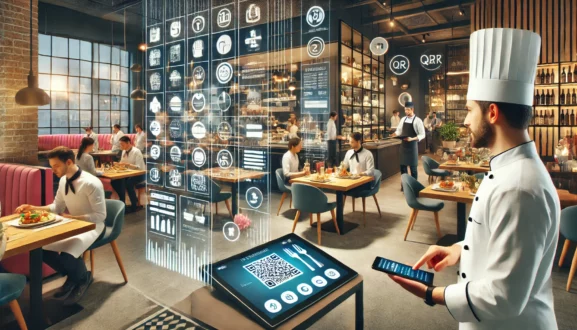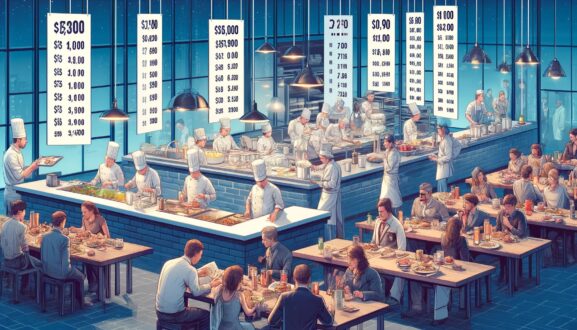Restaurant KPIs Decoded: The Ultimate Guide to Cooking Up Success
Imagine this: It’s Friday night at your favorite restaurant. The kitchen is buzzing like a beehive, the waiters are ballet dancing between tables, and the air is filled with the aroma of sizzling garlic and fresh herbs.
Now, picture being the maestro of this orchestrated chaos – the restaurant owner or chef. Sounds thrilling, right? But here’s a little secret: the real magic happens behind the scenes, in the numbers.
You might think that gut feelings and a passion for food are all it takes to run a successful restaurant. And while those ingredients are essential, there’s another crucial element to the recipe for success: Key Performance Indicators, or KPIs.
Think of KPIs as the spices in your pantry. Just as the right combination of spices can elevate a dish, tracking the right KPIs can lift your restaurant to new heights of success.
Why set Restaurant KPIs?
Ever tried whipping up a new dish without a recipe? It can be fun, adventurous, but also a bit hit or miss. Running a restaurant without keeping an eye on your KPIs is similar. You might have some wins by chance, but you’ll also face unnecessary risks. KPIs are like your recipe book for success, offering clear, measurable insights into how well your restaurant is performing.
By tracking these metrics, you’re not just looking at numbers. You’re uncovering stories about your restaurant’s performance. Which dishes are your crowd-pleasers? What times of the day do you shine brightest? Where are the leaks that need plugging? KPIs offer you these insights and more, helping you make informed decisions that boost your restaurant’s efficiency, popularity, and profitability.
KPIs turn the complex, dynamic operation of a restaurant into clear, actionable data. They help you spot trends, make adjustments, and set goals. In other words, they’re not just indicators; they’re your roadmap to a thriving restaurant.
Essential Restaurant KPIs grouped per category
Sales & Profitability KPIs
- Sales by Category (Food, Beverage, Merchandise): Understand which menu categories are the most popular and profitable.
- Average Revenue Per Customer: Gauge how much each customer contributes to your revenue, helping in setting pricing strategies.
- Gross Profit Margin: A crucial indicator of your restaurant’s financial health, showing the percentage of revenue that exceeds the cost of goods sold.
- Break-even Point: Determine the amount of revenue needed to cover total costs, indicating financial stability.
- Cost of Goods Sold (COGS): Monitor the direct costs tied to producing the food and beverages you sell, crucial for managing profit margins.
Operational Efficiency KPIs
- Table Turnover Rate: Measure how efficiently tables are being utilized and service is delivered.
- Labor Cost Percentage: Keep tabs on the proportion of revenue spent on staff to ensure optimal service without overspending.
- Inventory Turnover Ratio: Track how frequently you restock ingredients, aiming for freshness and minimal waste.
- Average Table Occupancy: Evaluate the percentage of tables occupied during a given time frame, optimizing space and service.
Customer Experience KPIs
- Customer Retention Rate: Understand the percentage of repeat customers, a key indicator of guest satisfaction and loyalty.
- Online Reviews and Ratings: Gauge public perception and online reputation, crucial in today’s digital world.
- Customer Satisfaction Score: Direct feedback from customers about their dining experience.
- Net Promoter Score (NPS): Measure the likelihood of customers recommending your restaurant to others.
Employee Engagement KPIs
- Employee Satisfaction: Assess how happy and engaged your staff is, directly impacting customer service and operational efficiency.
- Employee Turnover: Monitor the rate at which staff leave and are replaced, indicating the health of your workplace environment.
Marketing Effectiveness KPIs
- Return on Investment (ROI) for Marketing Campaigns: Evaluate the efficiency and profitability of your marketing initiatives.
- Spend per Head: Understand the average amount each customer is spending, informing menu pricing and marketing strategies.
Additional Essential Restaurant KPIs
- Average Table Occupancy: This metric reveals the average number of tables occupied over a specific period. It’s like measuring the popularity of your restaurant at different times, helping you adjust staffing and operational strategies.
- Spend per Head: Reflects the average amount spent by each customer. This KPI is a direct indicator of your menu’s attractiveness and your team’s upselling skills.
- Employee Turnover: A high turnover can indicate underlying issues in management or workplace culture, while a lower rate suggests a stable and potentially happier workforce. It’s about understanding the dynamics of your team and striving for a supportive environment.
With this structured approach, breaking down KPIs into specific categories, restaurant owners and chefs can more easily identify which areas of their operation need attention.
Whether it’s boosting sales, enhancing customer experience, improving operational efficiency, or fostering a better work environment for employees, focusing on these KPIs can guide strategic decisions and actions.
Wrapping up Restaurant KPI’s
There you have it, the secret ingredients to not just surviving but thriving in the bustling world of the restaurant business.
By tracking these KPIs, you’re not merely observing numbers; you’re diving deep into the heart of your restaurant’s story, understanding its pulse, and readying yourself to write the next chapter.
But remember, the beauty of KPIs lies not just in their tracking but in the actions you take based on what they reveal.
Like a chef tweaking a recipe to perfection, use these insights to adjust, experiment, and refine your strategies.
Whether it’s optimizing your menu, enhancing the customer experience, or creating a happier workplace for your team, these KPIs are your compass, guiding you toward success.
So, to all the restaurant owners and chefs out there, start if you haven’t already. Let them be your guide in the dynamic dance of the restaurant world.
And remember, tracking KPIs is a journey of continuous improvement. It’s about setting a course, adjusting as you go, and savoring the victories along the way.



Pingback: 17 Essential Restaurant Review Websites & How to Dominate
Pingback: Restaurant CoGS: Mastering the Backbone of Restaurant Profitability